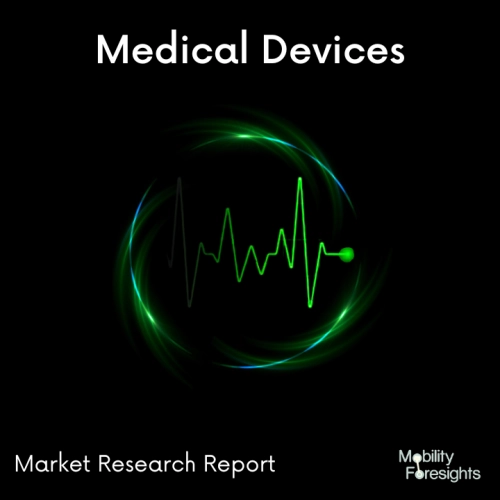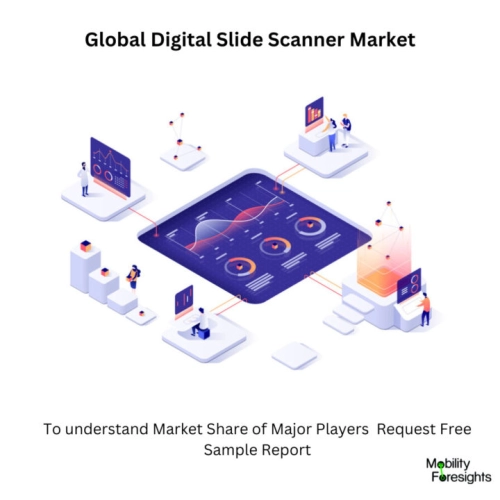
- Get in Touch with Us

Last Updated: Apr 25, 2025 | Study Period: 2024-2030
The digital slide scanner market is expected to experience steady growth throughout 2024-2030, fueled by advancements in healthcare and growing demand for digital pathology.
This technology allows high-resolution scanning of glass slides, facilitating remote analysis and collaboration among pathologists. Rising cancer rates and increasing focus on efficient workflows in pathology labs further drive the market.
The market is segmented by type (brightfield, fluorescence etc.) and application (scientific research, medical diagnostics). Brightfield scanners dominate due to their widespread use in routine pathology.
Geographically, North America and Europe are expected to hold the largest market share due to established healthcare infrastructure and high adoption rates. However, the Asia Pacific region is anticipated to witness the fastest growth due to increasing investments in healthcare and rising awareness.
Key factors influencing market growth include:
However, the high cost of scanners and recurring software licensing fees may hinder market growth in some regions. Additionally, data security concerns surrounding digital pathology workflows need to be addressed.
Looking ahead, advancements in artificial intelligence and machine learning are expected to revolutionize the digital slide scanner market. AI-powered image analysis tools can aid pathologists in faster and more accurate diagnoses.
Furthermore, the development of cloud-based digital pathology solutions will enhance accessibility and affordability, fostering wider adoption in resource-constrained settings.
Overall, the digital slide scanner market presents a promising outlook for the coming years, driven by the growing need for efficient and accurate pathology workflows in an increasingly digital healthcare landscape.
A digital slide scanner is a sophisticated imaging device used primarily in the field of pathology to convert glass slides containing tissue samples into high-resolution digital images. These scanners employ advanced optics and imaging sensors to capture microscopic details of tissue samples, allowing pathologists and researchers to view, analyze, and share images electronically.
There are several types of digital slide scanners available in the market, including brightfield scanners, fluorescence scanners, and confocal scanners. Brightfield scanners are the most common type, suitable for routine pathology examinations, while fluorescence scanners are used for imaging fluorescently labeled specimens, and confocal scanners offer enhanced optical sectioning capabilities for three-dimensional imaging.
The benefits of digital slide scanners include improved diagnostic accuracy through enhanced visualization of tissue samples, streamlined workflow efficiency by enabling remote access and collaboration, and the facilitation of educational purposes through digital archives and sharing capabilities. Additionally, digital slide scanners can contribute to cost savings by reducing the need for physical storage space and minimizing the risk of slide damage or loss.
However, digital slide scanners also pose certain risks and challenges. One major risk is the potential for data breaches or unauthorized access to sensitive patient information stored within digital images. Ensuring robust cybersecurity measures and compliance with data protection regulations is essential to mitigate this risk. Furthermore, the initial investment and ongoing maintenance costs associated with digital slide scanners can be substantial, particularly for high-end models with advanced features.
Moreover, challenges related to standardization, interoperability, and image quality consistency across different scanners and software platforms need to be addressed to facilitate seamless integration into existing pathology workflows and ensure reliable diagnostic results. Additionally, training pathologists and laboratory staff to effectively utilize digital slide scanners and interpret digital images accurately is crucial for maximizing the benefits of this technology while minimizing the potential for errors or misdiagnoses.

The global Digital slide scanner market accounted for $XX Billion in 2023 and is anticipated to reach $XX Billion by 2030, registering a CAGR of XX% from 2024 to 2030.
Integration of artificial intelligence (AI) and deep learning algorithms into digital slide scanners is a key trend, enabling automated image analysis and interpretation, thereby enhancing diagnostic accuracy and efficiency.
Rising adoption of cloud-based digital pathology solutions is an emerging trend, facilitating remote access to digital slide images, seamless collaboration among healthcare professionals, and centralized data storage for large-scale analysis.
Increasing focus on developing compact and portable digital slide scanners is a notable trend, catering to the growing demand for point-of-care diagnostics and enabling pathology services in resource-limited settings.
The implementation of blockchain technology for secure storage and sharing of digital pathology images is gaining traction, addressing concerns related to data integrity, authenticity, and privacy.
Growing interest in virtual reality (VR) and augmented reality (AR) applications for digital pathology is an emerging trend, allowing pathologists to immerse themselves in virtual slide environments for enhanced visualization and analysis.
Expansion of digital pathology beyond traditional histopathology to include other disciplines such as cytology, hematology, and microbiology is a notable trend, broadening the scope of applications for digital slide scanners in diagnostic laboratories.
Increasing investment in research and development of next-generation digital slide scanner technologies, including multispectral imaging and super-resolution microscopy, is driving innovation and pushing the boundaries of image quality and resolution.
Emphasis on interoperability and standardization efforts within the digital pathology ecosystem is a key trend, aiming to ensure compatibility between different hardware and software platforms, facilitate data exchange, and promote seamless integration with electronic health record systems.
Adoption of telepathology and digital consultation services is on the rise, enabling remote diagnosis, second opinions, and expert consultation, particularly in underserved regions with limited access to pathology expertise.
Heightened focus on regulatory compliance and quality assurance in digital pathology, including adherence to standards such as ISO 15189 and FDA regulations, is a notable trend, underscoring the importance of maintaining the highest standards of patient safety and diagnostic accuracy.
Roche announced the CE launch of the VENTANA DP 600 slide scanner's new generation (CE-IVD marked).
This high-capacity slide scanner provides the pathology lab with simplicity of use and workflow flexibility while producing stained histology slides with exceptional image quality from patient tissue samples.
The development of individualised health care relies heavily on the VENTANA DP 600 slide scanner. This method can help guarantee that every patient receives the most effective treatment plan possible when combined with our cutting-edge AI image analysis algorithms, according to the CEO of Roche Diagnostics.
Additionally, it opens up possibilities for improved communication and remote diagnosis, which can save lives in regions with poor access to pathologists.
The VENTANA DP 600 slide scanner is a significant addition to the Roche Digital Pathology portfolio, which offers cutting-edge, premium digital solutions that automate tissue diagnostics and enable pathologists to give healthcare professionals and their patients faster, more thorough diagnostic results.
Digital pathology is the digitalization of the conventional pathology workflow, which begins with slide scanning and continues through analysis and visualisation.
Traditional histopathology is being transformed by digital pathology, which increases workflow efficiency, analytical depth, and opportunities for cooperation.
By Geography:
By Type:
By Application:
By End User:
| S No | Titles |
| 1 | Market Segmentation |
| 2 | Scope of the Report |
| 3 | Research Methodology |
| 4 | Executive Summary |
| 5 | Introduction |
| 6 | Average B-2-B Selling Price in Past 5 Years |
| 7 | Insights from Industry Stakeholders |
| 8 | Cost Breakdown of Product Components and Average Profit Margin |
| 9 | Disruptive Innovation in the Industry |
| 10 | Technological Innovations in Digital Slide Scanner Market 2024-2030 |
| 11 | Imaging Technologies for Digital Slide Scanning |
| 12 | Automation and Robotics in Slide Handling |
| 13 | Image Analysis and Management Software |
| 14 | High-Throughput Scanning and Large Image Management |
| 15 | Artificial Intelligence and Machine Learning in Digital Pathology |
| 16 | Telepathology and Remote Collaboration |
| 17 | Standardisation and Interoperability |
| 18 | Challenges and Limitations of Current Technology |
| 19 | Future Outlook and Innovation Trends |
| 20 | New Product Development in the Past 12 Months |
| 21 | Market Size, Dynamics, and Forecast by Geography (2024-2030) |
| 22 | Market Size, Dynamics, and Forecast by Product Type (2024-2030) |
| 23 | Market Size, Dynamics, and Forecast by Application (2024-2030) |
| 24 | Market Size, Dynamics, and Forecast by End User (2024-2030) |
| 25 | Competitive Landscape and Market Share Analysis |
| 26 | Growth Strategy of Leading Players |
| 27 | Market Share of Vendors (2023) |
| 28 | Company Profiles |
| 29 | Unmet Needs and Opportunities for New Suppliers |
| 30 | Conclusion |